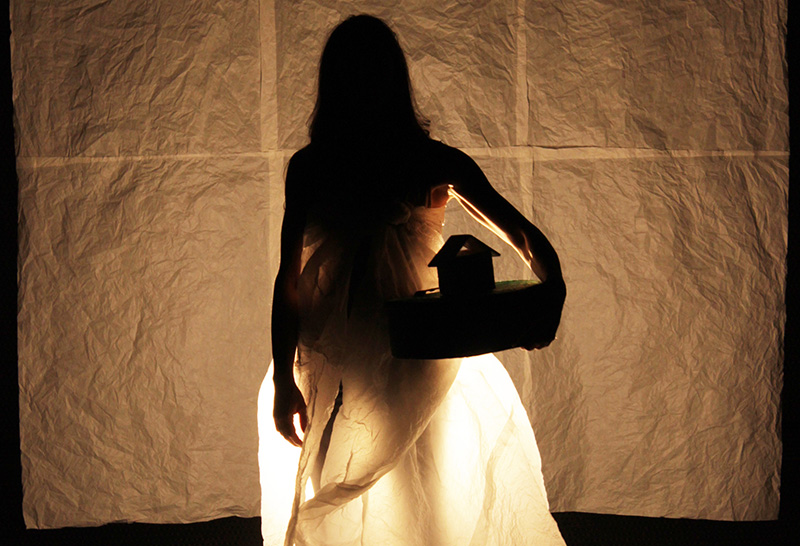 D-Code starts slowly: a crumpled paper sheet, the size of a person – maybe a map, maybe a patchwork of newspaper clippings, something we can’t make out – twists and lifts in a breeze we can’t perceive. As the sheet, which seems to have vital information on it somehow, becomes more animated, a form becomes visible beneath it. This is more than flotsam, this is someone, being carelessly cast around by the elements.
D-Code starts slowly: a crumpled paper sheet, the size of a person – maybe a map, maybe a patchwork of newspaper clippings, something we can’t make out – twists and lifts in a breeze we can’t perceive. As the sheet, which seems to have vital information on it somehow, becomes more animated, a form becomes visible beneath it. This is more than flotsam, this is someone, being carelessly cast around by the elements.
‘Did you know that humans were nomads for three million years?’ asks a disembodied voice. At the end of this drifting sequence, up from the ground, in a chrysalis of tissue paper, rises the form of Yael Karavan. Finally revealed, ‘the human behind the sheet of paper’, she takes us, through impeccable physical manipulation, through the entire evolution of homo sapiens, from the first legless creatures crawling through the primordial ooze to an upright dancer skimming the ground. It’s a simple concept but so eloquent in context – the fabrication of countries and the idea that people are possessed by a specific patch of ground is so ludicrous against the scale of how we came to be here at all.
The tension in this piece is always between the personal and the political. Although it has been in progress for a couple of years now, D-Code could not be more topical, with the mass deportation of displaced peoples happening even as I type. Karavan’s wise choice not to root the core story in one specific state, or conflict, not to hone in on one specific and literal message, or speak directly to the audience at any length (relying instead on recorded voices), is to the benefit of this show, keeping a universal relevance. It would make an eloquent double bill with Joe Sellman-Leava’s verbose Labels.
Karavan’s distinctive language of movement is always compelling to watch, and here she is complemented to great effect by the striking production design. Projection is used astutely to create some truly remarkable visuals. Torn scraps of paper become treasured photographs burning up in the ruins of a bombed out house, Karavan’s white translucent mac becomes a canvas painted with light and data.
We see a spiralling DNA sequence fill her outline with GATCs, then a diagram of blood vessels, then a map; all the while a recorded voice gives a litany of genetic heritage, ‘12% Italian, 3% English 0.2% Belarusian…’ So many nations it becomes meaningless. All the while Karavan’s illuminated outline glows on the wall behind her. It’s an unforgettable visual that transcends the message of D-Code to be art in its own right.
The set is spare: a bare floor and three big paper flats in a rough semi-circle bordering the upstage space. Karavan opens a suitcase centre stage and a perfect model house sits within, on a carefully manicured lawn. An hour with just a handful of props and herself; no flashy gimmicks needed.
In one of many richly visual moments in D-Code Karavan stands centre stage, mostly silhouetted by warm white sidelight, and slowly turns while red sand pours from her outstretched fists. It was inexplicably pleasing to see a perfect circle ascribed around her bare feet in scarlet grains of sand, marking out one human’s allocation of space on the Earth.
As the narration speaks of nation the three banner-like background flats are lit in red, white, and blue – the iconography of a flag is that of a person divided by cartography and governments. In scenes of conflict they glow a deep bloody red. In two sequences Karavan simply and powerfully lights herself with a handheld torch, focusing on her feet as she is chased from nation after nation, or on each limb and extremity as they are assigned a country of origin.
The simplicity and clarity of production design, and the subtle complexity of Carl Beukman’s compositions, the soundscape that underscores it all, tie Karavan’s performance into an elaborate sensory immersion. At one point a layered series of voiceovers, in all of the languages Karavan holds under her tongue, escalates into a veritable Babel while, with controlled wildness, she flings herself through a rhythmic sequence of movements – each tied to a place she could be said to be from – hopping barefoot over battle lines she herself has drawn in gravel on the ground.
Particularly deserving of mention is the haunting mask work with a sheet of torn tissue paper. The eerie disembodiment effected by the blank sheet in place of a face succinctly and definitively answers the core question: of course a human is more important than the written papers that represent them.
There are many aspects and individual moments that could be singled out, but it is in the sum of its parts that D-Code holds its power. The rich tapestry of visuals with a strong, but mostly unspoken undercurrent of political and personal crises (and resolution) of identity and global displacement is a pleasure to watch, yet also provokes sentiments that are beyond words. I left the performance with a sense of belonging, of sisterhood with humans from anywhere who can move and create and appreciate beauty.

